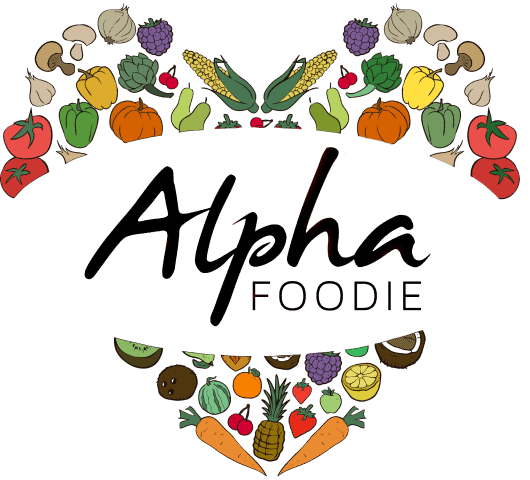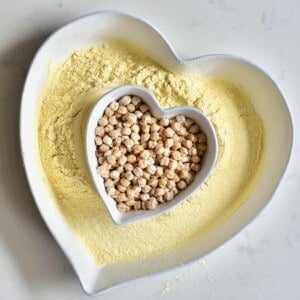This post may contain affiliate links. Please read our disclosure policy.
Make the best hummus like a pro! My mom’s hummus recipe uses chickpeas (canned or dried), tahini, and lemon juice or citric acid. It’s perfect with veggies or pita. Detailed steps, tips, and a video are included!

Hummus is a popular Middle Eastern dip or spread, essential in Lebanese cuisine—no Lebanese mezze is ever complete without it! So, let me share Mom’s favorite way to prepare this creamy and smooth hummus—and how I love to enjoy it at home.
Making hummus at home is both easy and enjoyable. Plus, it’s SO much better than store-bought! This authentic recipe requires you to blend cooked chickpeas with tahini (sesame paste), lemon juice or citric acid (for a longer shelf life), and ice cubes until it reaches a smooth texture. All my top tips will help you make hummus like a pro. Make sure to watch the video too!
You can then enjoy this healthy dip with veggies and pita, add it to sandwiches, or serve it alongside Middle-Eastern dishes like baba ganoush, shish tawook, and Lebanese garlic sauce.

Want to save this recipe?
Watch the recipe video tutorial
Ingredients

- Chickpeas (garbanzo beans): You can use cooked chickpeas (from dried) or canned chickpeas. For a super creamy, smooth mixture, it’s best to use “mushy” (overcooked) chickpeas.
- Tahini: I use homemade tahini. If you’re using store-bought, try using a raw, unsalted option. It adds a nutty flavor & richness.
- Lemon juice or citric acid: I usually use lemon juice, but citric acid is also great because it has a stable pH, resulting in a longer shelf life.
- Salt.
- Olive oil: I love adding a bit of olive oil as it helps with the creaminess and prevents the hummus from drying out in the fridge.
- Ice cubes: They help cool down the cooked chickpeas and make a fluffier homemade hummus.
- Water: Ice water also helps to achieve incredible silky results. You can also use the aquafaba from cooking the chickpeas.
- Garlic: I love adding garlic. You can omit it if preferred.
See the printable recipe card below for full information on ingredients and quantities.
How to make hummus
Cook the chickpeas: Whether you are using canned or dried chickpeas, I recommend boiling them until they are mushy. For canned chickpeas, just rinse them, add them to a saucepan with plenty of water and one teaspoon of baking soda, and cook them for 20-30 minutes until they get mushy. They should be very easy to squeeze with your fingers.
When cooking dried chickpeas from scratch, first rinse them under cold water. Then, soak them in a large bowl with plenty of water for 6 hours or overnight (they will double or even triple in size).
Drain and rinse them thoroughly, then place them in a large pot and cover with fresh water. Bring to a boil over high heat and skim the foam that forms. Finally, once the chickpeas are not producing any more foam, add baking soda (it will fizz, but that’s OK). Cook for 1 to 1.5 hours or until the chickpeas become soft. For more tips, you can check my post on how to cook dried chickpeas.

Blend chickpeas with ice: Once the chickpeas are soft and mushy, drain them (you can reserve some of the cooking water). Transfer them to your food processor or blender. Add the ice cubes and blend till mostly uniform and incorporated. We will keep on blending as we add the other ingredients so the texture will eventually become extra smooth and creamy.

Add lemon juice (or citric acid) and salt: Once the chickpeas are mostly blended, add the lemon juice (or citric acid) and salt. Blend again to incorporate them.

Add tahini (sesame paste): Finally, add the tahini and garlic. Blend until you achieve a smooth and creamy texture. Pause a couple of times to scrape down the sides if necessary.
You can make hummus in any food processor, but if your machine is not too powerful, blend for a few extra minutes, and it will become smoother. If the hummus is too thick for your taste, you can add a bit of ice water or aquafata (a tablespoon at a time) until you achieve your preferred consistency.

Finally, taste the hummus. Taste test and adjust the flavor according to your preferences. Once you’re happy with it, serve and garnish with fresh parsley, a few whole chickpeas, a sprinkle of red chili powder or paprika, and a drizzle of olive oil!

Pro tips for the best hummus
- Soak Dry Chickpeas then Boil Them. Make sure to soak them overnight before boiling them with baking soda. Even if you are using canned chickpeas, cook them to make them soft and mushy.
- Remove the Foam that collects at the top when boiling the chickpeas. Doing so helps to get rid of impurities. It also reduces compounds that cause gas and bloating, making your hummus easier to digest.
- Mushy Chickpeas are key! Make sure they’re super soft for the smoothest hummus.
- Not a Garlic Fan? Use roasted garlic in the oven instead if you’re not into that strong garlic taste.
- Citric Acid has a stable pH, which results in a longer shelf life. However, I often use lemon juice instead.
Hummus recipe variations
I love the authentic taste of this recipe. But I also love experimenting with different flavors and hummus variations. I have shared a few different recipes already, but here are my favorite ways to bring more excitement to this recipe:
- Roasted pepper hummus: Add one or a few roasted peppers and blend them with the rest of the ingredients. You will get a smoky, sweet and savory hummus with an orange color.
- Beet hummus: Make pink hummus by blending a roasted beet in the mixture. It’s a deliciously earthy, sweet, and savory variation.
- Fresh basil hummus: Blend a bunch of fresh basil with the hummus ingredients for a vibrant green dip. Alternatively, you can mix in a spoonful of basil pesto in your ready hummus.
- Pumpkin hummus: Make a fall-inspired dip that’s perfect for Halloween and Thanksgiving. Use pumpkin puree or roasted pumpkin and blend it with the rest of the ingredients for a fun fall twist.
- Extra garlicky hummus: I love the pungent flavor of hummus and often add several garlic cloves to it. You can also use roasted garlic for a more mellow taste.
- Spicy hummus: Add your favorite spice to create a brand-new variation. I love adding turmeric powder (make it golden yellow, too), extra paprika or chili powder, or even cumin or coriander powder.
- Chocolate hummus: Did you know you can make sweet hummus and enjoy it for dessert? Use cacao powder, an optional espresso shot, and a bit of a sweetener to turn this hummus recipe into a delicious chocolate treat.
What to serve with hummus
I like to eat it with bread/pita alongside some veggies, which complements its flavors perfectly. But there are endless ways to enjoy homemade hummus! Here are some of my favorites:
- Spread: Perfect for sandwiches, wraps, burgers, and alongside warm Pita bread.
- Dip: Enjoy it with crunchy veggies like carrots, celery, and cucumbers, homemade pita chips, and savory homemade seed crackers.
- Side: Enjoy as a tasty side addition to dishes like shish tawook, chicken shawarma, and kofta kebab.
- Mezze and platters: Serve alongside baba ganoush, tzatziki sauce, flavorful baked falafel, refreshing tabouli salad, and fattoush salad. You can also add beef shish kabobs or kofta kebabs. These are all great for large gatherings and parties!

FAQs
No, you don’t need to peel the chickpeas. I rarely ever, if ever, peel my chickpeas. Peeled chickpeas can indeed yield smooth results. However, if you follow my top tips for smooth and creamy hummus, then there’s no need to peel them.
Place it in an airtight container and keep it in the refrigerator for up to 1 week. For longer storage, freeze it in portions in freezer-safe containers or zip-top bags, removing excess air and leaving room for expansion. Frozen portions can maintain their quality for up to three months. Thaw in the refrigerator overnight before serving.
Technically, if you substitute the tahini (or omit it), it wouldn’t be an authentic hummus recipe. However, you can substitute it for cashew butter or sunflower seed butter. Though the flavor won’t be the same.
More chickpea recipes
If you try this homemade hummus, let me know how it goes in the comments below. I’d appreciate a recipe card rating and would love to see your recipe recreations – tag me on Instagram @Alphafoodie!

Mom’s Best Hummus Recipe (With Video)
Equipment
Ingredients
- 18 oz cooked chickpeas 3 cups (or 2 x15 oz cans of canned chickpeas)
- 1/4 cup tahini
- 1/3 cup lemon juice or 1/2 Tbsp citric acid
- 1 Tbsp olive oil
- 3 cloves garlic
- 1/2 Tbsp sea salt or season to taste
- 6 ice cubes
- 1/4 cup ice water or aquafaba, optional to change the consistency
Instructions
- Whether using dried or canned, cook them until they are very soft. For canned chickpeas, rinse them and put them in a pot of water and one teaspoon of baking soda. Boil for about 20-30 minutes until they get mushy. Drain them in a sieve.For dried chickpeas, rinse them under cold water and soak them for a minimum of 6 hours. Then, cook them in plenty of water and one teaspoon of baking soda until soft and mushy (about 1-1.5 hours). Drain them in a sieve. For more tips, check my post How to Cook Dried Chickpeas.
- In a food processor, blend the cooked chickpeas with the ice cubes until mostly uniform and incorporated.
- Add the lemon juice (or citric acid) and salt and blend to incorporate them.
- Add the tahini and garlic. Blend until you achieve a smooth and creamy texture. Pause the blending and scrape the sides a few times as needed. Blend until you reach your desired consistency—if needed, add some of the water.
- Taste and adjust the flavor according to your preferences.Serve the homemade hummus garnished with parsley, whole chickpeas, red chili powder, and a drizzle of olive oil for added flavor and presentation.
Video
Notes
Nutrition
Nutrition information is automatically calculated, so should only be used as an approximation.













Best hummus ever! I use dried and soaked chickpeas and a cup of the chickpea cooking liquid/aquafaba (minus a little) chilled instead of the cold water and add cumin, paprika and olive oil. Amazing every time, thanks!
So happy you like the recipe! Thank you for your comment!
In your book “Lebanese Cuisine” for your hummus recipe (p. 32) you use sesame taratur (p 251) instead of tahini. What is the difference?
Hi Thomas!
The main difference is that tahini is made only from ground sesame seeds. At the same time, the taratur has sesame seeds, lemon juice, and garlic. Using taratur adds a more pronounced lemony-garlicky flavor, but hummus is also delicious with just tahini.
I forgot to add the baking soda while i soaked the beans, so I put it in when I cooked them in a pressure cooker (16 minutes, manual release)… and this will be the first time in 5 tries that the beans came out mushy!!! I’m so excited. Thank you for this recipe, it is delicious!
So happy you gave this recipe a try, Jenna. Indeed, you can add baking soda when cooking them too!
Always delicious
Glad you enjoyed it, Rachel!
Made it for the first time, and followed all your tips! It’s really delicious and so simple. I had no idea I liked hummus so much
So happy to hear this, Alessia! Glad you liked it!
Do you start with two cups of dried chickpeas? Or do you only use two cups of the cooked chickpeas?
Hi Stephanie,
You need 2 cups of cooked chickpeas. As they double in size when soaking, you can start with about 1 cup of dried chickpeas.
Hi Samira!
Finally I tried your recipe. It was my first try then it turns out LIT!
I took note and pay attention to your tips and OMG my family loved it.
Thank you Samira ❤️.
Thank you so much for your comment, Dieka! So happy you tried and enjoyed the recipe 🙂
So simple, so amazingly delicious!!! The overcooked chickpeas is the best hack for the creaminess. Thanks a lot, Samira, you’re the best!
Greetings from Mexico 🙂
This is my favourite hummus recipe! I think the ‘overcooking’ tip makes a big difference. I make big batches to freeze and find it thaws and tastes great. The only difference post-thawing is the texture is slightly less creamy/incorporated. I like to top with olive oil and smoked paprika.
Thank you for your comment, Giselle! So happy you’ve enjoyed this recipe. After thawing, you can blitz it in the blender to make it more incorporated.